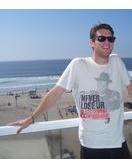
Here’s Eck posing for Playboy in 1980.
America’s hipsters and post-ironic trust fund kids may be growing out their mustaches now, but baseball players of the 70’s had little idea of how their ‘staches (which were considered masculine) were actually a cultural influence initiated by gay culture. Dennis Eckersley no doubt had the most famous mustache in Oakland A’s history, (besides Rollie Fingers) and unlike most players in the 90’s, kept the mustache until it became hip again and still wears it today.
Starting with the ’60s, when hippie culture and gay culture seemed to collide, facial hair really got out of hand, as gay beat poet Allen Ginsberg and his bushy face exemplify. In 1969, with gay liberation after the Stonewall Riots, those on the front lines were the drag queens without a hair on their faces and the hippie types who wanted to buck the establishment and had nothing to lose. Again it was the smooth and the hairy in perfect harmony.
Things started to change in the ’70s, as the proliferation of gay porn, the popularization of disco (a gay sub-culture) and an exploding gay culture gave birth to what is known as “the clone look,” which started with super-popular gay porn star Al Parker. You couldn’t swing a handbag on The Castro without hitting a guy with a beard and a mustache, and everyone felt the need to conform because not only was it a way to spot other gays but it was the beauty ideal, and something that was considered masculine. Gay icons like Freddie Mercury, the Village People, and John Waters were all known for their iconic mustaches.
A landmark film from 1972 was Deep Throat, which made perhaps up to $600 million (no one really knows the exact figures…probably not even the mobsters who backed it) and kicked off the era of ’70s “porno chic.” Along with the other major male porn stars of the time, like John Holmes and Ron Jeremy who made mustaches synonymous with sleazy sexual appetites, perhaps leading to their public decline in the gay community and lending itself towards a more “macho” mainstream appetite.
The 1990’s unfortunately became a fallow time for mustaches, which were associated with the past two decades and seen as cheesy and unhip. Now, of course, they’re making a huge comeback as today’s cool kids, who reach back for the circa-1900 look and who have a keen taste for irony since they can’t define their own media-obsessed generation by any clear materialized pop-cultural definition.

